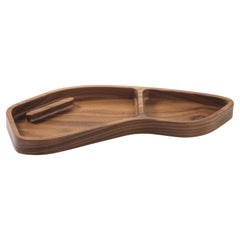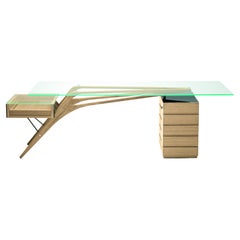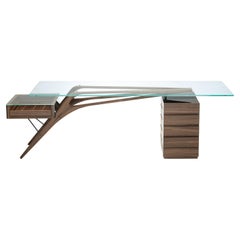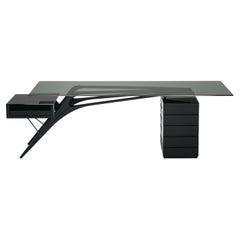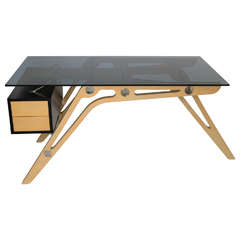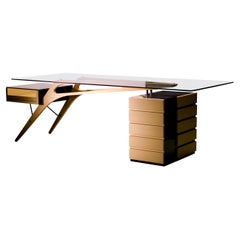Carlo Mollino Cavour Desk
Zanotta Cavour CM Executive Kit in Canaletto Walnut by Carlo Mollino
By Zanotta, Carlo Mollino
Located in Brooklyn, NY
Zanotta Cavour CM Executive Kit in Canaletto Walnut by Carlo Mollino
Legs in solid natural or
Category
21st Century and Contemporary More Desk Accessories
Materials
Walnut
$3,080 / item
H 2.5 in W 35 in D 15 in
Zanotta Cavour CM Writing Desk in Clear Glass Top with Natural Oak Frame
By Carlo Mollino, Zanotta
Located in Brooklyn, NY
Zanotta Cavour CM Writing Desk in Clear Glass Top with Natural Oak Frame by Carlo Mollino
Legs
Category
21st Century and Contemporary Desks and Writing Tables
Materials
Oak
$20,801 / item
H 29 in W 97 in D 35 in
Zanotta Cavour CM Writing Desk in Clear Glass Top with Canaletto Walnut Frame
By Carlo Mollino, Zanotta
Located in Brooklyn, NY
Zanotta Cavour CM Writing Desk in Clear Glass Top with Canaletto Walnut Frame by Carlo Mollino
Category
21st Century and Contemporary Desks and Writing Tables
Materials
Walnut
$20,801 / item
H 75 in W 247 in D 90 in
Zanotta Cavour CM Writing Desk in Smoky Glass Top with Black Varnished Oak Frame
By Carlo Mollino, Zanotta
Located in Brooklyn, NY
Zanotta Cavour CM Writing Desk in Smoky Glass Top with Black Varnished Oak Frame by Carlo Mollino
Category
21st Century and Contemporary Desks and Writing Tables
Materials
Oak
$22,638 / item
H 75 in W 247 in D 90 in
Recent Sales
Zanotta Cavour Desk, Homage to Carlo Mollino
By Zanotta
Located in Rome, IT
Zanotta Cavour desk, homage to Carlo Mollino, prod. Italy, circa 2009.
Free shipping to London.
Category
Early 2000s Italian Desks and Writing Tables
Carlo Mollino Cavour Desk by Zanotta
By Carlo Mollino, Zanotta
Located in Dronten, NL
An elegant and streamlined writing desk featuring a glass top and bleached oak frame.
Bleached
Category
Mid-20th Century Italian Mid-Century Modern Desks and Writing Tables
Materials
Glass, Oak
Zanotta Cavour Desk, Homage to Carlo Mollino
By Zanotta
Located in Dallas, TX
"Cavour" writing desk, homage to Carlo Mollino, 1949.
Zanotta edition.
Plate glass top, natural
Category
20th Century Italian Desks and Writing Tables
Materials
Glass
Cavour CM Desk w/ Executive Kit, Canaletto Walnut Frame with Clear Glass Top
By Zanotta, Carlo Mollino
Located in Vancouver, BC
Designed by Carlo Mollino in 1949 for Zanotta, the Cavour Desk forms part of an eccentric yet
Category
2010s Italian Modern Desks
Materials
Glass, Walnut
H 29.5 in W 97.24 in D 35.43 in
Zanotta Cavour CM desk designed by Carlo Mollino in 1949
By Carlo Mollino
Located in Oirlo, LI
Zanotta Cavour CM desk designed by Carlo Mollino in 1949
The Zanotta desk is a design from 1949 by
Category
Vintage 1980s Italian Modern Desks and Writing Tables
Materials
Glass, Wood
Cavour Desk by Zanotta, Homage to Carlo Mollino
By Carlo Mollino, Zanotta
Located in Dronten, NL
An elegant and streamlined writing desk featuring a glass top and bleached oak frame.
Bleached
Category
Mid-20th Century Italian Mid-Century Modern Desks and Writing Tables
Materials
Glass, Oak
Carlo Mollino “Cavour” Office Desk – With Tempered Glass Top
Located in Barrowford, GB
aware by your interest in this homage to the original (but significantly larger) Carlo Mollino creation
Category
2010s Desks and Writing Tables
Materials
Glass
Zanotta Cavour CM Homage to Carlo Mollino
By Zanotta
Located in New York, NY
Writing desk. Legs in solid natural oak, Extractable open tray and drawer element both covered with
Category
2010s Italian Desks and Writing Tables
Materials
Glass, Oak
Zanotta Cavour CM Desk in Black Varnished Oak Frame by Carlo Mollino
By Carlo Mollino, Zanotta
Located in NIJMEGEN, NL
Desk is a design from 1949 by the eccentric Italian designer and architect Carlo Mollino. This desk is
Category
Vintage 1940s Italian Mid-Century Modern Desks and Writing Tables
Materials
Glass, Oak
H 29.93 in W 97.25 in D 35.44 in
People Also Browsed
1960s Paris Holophane Globe Street Pendant Light Qty Available
By Holophane
Located in New York, NY
This Holophane Paris Street light, transformed into a mesmerizing light fixture, is a captivating blend of history and modern design. Originally conceived in the mid 20th century, th...
Category
Mid-20th Century French Industrial Chandeliers and Pendants
Materials
Steel
Silvio Coppola for Bernini Set of Four Dining Chairs in Brown Leather
By Silvio Coppola, Bernini
Located in Waalwijk, NL
Silvio Coppola for Bernini, set of four dining chairs model 330, leather, walnut, Italy, 1960s.
This magnificent set of dining chairs by the renowned Italian designer Silvio Coppola...
Category
Vintage 1960s Italian Mid-Century Modern Dining Room Chairs
Materials
Leather, Beech
$5,200 / set
H 31.7 in W 18.9 in D 18.51 in
Vesta Rattan Table Lamp
Located in Oxford, GB
Vista Rattan Table Lamp with Brass Shade Top
A harmonious fusion of organic charm and refined elegance, the Vista table lamp captivates with its petite silhouette and artisanal cr...
Category
2010s Philippine Mid-Century Modern Table Lamps
Materials
Brass
Green Glass Art Deco Style Ceiling Lamp, 1940s, Germany
Located in Hagenbach, DE
Green Glass Art Deco Style Ceiling Lamp, 1940s, Germany
Lampshade is in very good vintage condition.
This lamp works with E27 light bulbs.
Wired and suitable to use with 220V and ...
Category
Vintage 1940s German Art Deco Chandeliers and Pendants
Materials
Brass
Travertine Cat or Dog Bowl Set
By Kiwano Concept
Located in Eindhoven, NB
Unique and Stunning Pet bowl made of travertine stone. Expertly crafted and finished by hand, our travertine bowls are a study in sculptural simplicity. Natural variations in the sto...
Category
2010s Dutch Modern Decorative Bowls
Materials
Travertine
Serpentine Vertical Ceramic Wall Sconce by Farrah Sit - Single or Mirrored Pair
By Farrah Sit
Located in Brooklyn, NY
In this sandy slipcast ceramic wall sconce, generous curves are paired with crisp edges and the repetition of geometry to create a flow. The sconce snakes up and off the wall, a scul...
Category
2010s American Modern Wall Lights and Sconces
Materials
Brass
$2,200 / item
H 21 in W 4 in D 4 in
Armadillo 1 Dark Brown High Back Swivel Office Armchair by Rainer Bachschmid
By Altek Italia Design
Located in Milan, IT
Designed by Rainer Bachshmid as part of the Armadillo series of executive office seating, this elegant swivel armchair has it all. Equipped with a 5-spoked, cast-aluminum base that c...
Category
2010s Italian Office Chairs and Desk Chairs
Materials
Aluminum, Stainless Steel
$4,111 / item
H 47.3 in W 27.56 in D 27.56 in
Pair Table Mod.1176 Designed Max Ingrand for Fontana Arte Published and Signed
By Max Ingrand, Fontana Arte
Located in Rovereta, Repubblica di San Marino
Rare Pair coffee table mod.1176 designed by Max Ingrand for Fontana Arte in the 1960s. Conical base with flaring and top edged in brass which houses a crystal with a mirrored bluegro...
Category
Mid-20th Century Italian Mid-Century Modern Gueridon
Materials
Brass
On Hold
$15,560
H 24.81 in Dm 9.85 in
Pair of Midcentury Italian Amber Murano Wall Sconces by Mazzega, 1970s
By Mazzega 1946, AVMazzega, Mazzega
Located in Badajoz, Badajoz
Marvelous and unique Pair of Italian murano glass Wall Sconces from 1970s. These fixtures were designed and munufactured during the 1970s in Italy by Mazzega.
Each Wall Sconce is co...
Category
Vintage 1970s Italian Mid-Century Modern Wall Lights and Sconces
Materials
Metal, Brass
$4,291 / set
H 11.82 in W 6.3 in D 3.15 in
Mid-Century Italian Murano Glass Chandelier by Venini
By Venini
Located in North Bergen, NJ
Mid-Century Modern Italian chandelier by Venini. Each of the prisms is solid glass, measuring 11 inches and 4 inches. They hang from hooks onto a chrome frame, as pictured. Any amoun...
Category
Vintage 1960s Mid-Century Modern Chandeliers and Pendants
Ward Bennett for Brickell Newly Caned "Sled" Lounge Chair, Circa 1970
By Ward Bennett, Brickel Associates
Located in Bainbridge, NY
Original Chromed Steel & Cane Lounge Chair by Ward Bennett for Brickell. Featuring the vintage low chromed x frame, with newly natural and unstained cane seat, curved back, covered a...
Category
Vintage 1960s American Modern Lounge Chairs
Materials
Chrome
$4,500
H 30 in W 27.5 in D 30 in
Glas Italia OBLIQUO vertical shelving by Piero Lissoni
By Glas Italia, Piero Lissoni
Located in Brooklyn, NY
Series of open storage units in 4+6 mm laminated glass, with shiny
polished ground edge and heat-sealed at 45°. The external surface
has a special mirrored chrome finish, while the...
Category
21st Century and Contemporary Italian Shelves
Materials
Glass, Wood, Mirror
$12,364 / item
H 74.41 in W 35.44 in D 15.75 in
Mid-Century Modern Brass Chandelier by Lamperti Production Italy 1960
By Lamperti
Located in Palermo, IT
The elegance of this chandelier is the right word. Stunning and of considerable size. Brass structure with six glass balls. The peculiarity is the pearl effect that the glass balls h...
Category
Mid-20th Century Italian Mid-Century Modern Chandeliers and Pendants
Materials
Brass
$2,896
H 24.81 in W 37.41 in D 37.41 in
Edo Period Samurai Suit Of Armor
Located in New Orleans, LA
This exquisite Tetsusabiji Uchidashi Gomai Dou Gusoku (Five-Plate Russet Iron Embossed Cuirass Armor), crafted in the 18th century, exemplifies the pinnacle of Edo-period samurai arm...
Category
Antique 18th Century Asian Edo Arms, Armor and Weapons
Materials
Copper, Iron
Vintage Italian Coffee Table by Willy Rizzo
By Willy Rizzo
Located in Austin, TX
Iconic vintage Italian coffee table with chromed central compartment by Willy Rizzo. Renowned Italian designer Willy Rizzo designed this piece featuring a bottle holder in the center...
Category
Vintage 1960s Italian Mid-Century Modern Coffee and Cocktail Tables
Materials
Chrome
Pink and Ice Color Large Italian Murano Glass Tronchi Chandelier
Located in Rome, IT
This extraordinary chandelier is composed by 78 pink and ice color Murano glass 'Tronchi'
By 20 cm high.
Ten E 27 light bulbs.
Available also a pair.
Category
2010s Italian Mid-Century Modern Chandeliers and Pendants
Materials
Blown Glass
Get Updated with New Arrivals
Save "Carlo Mollino Cavour Desk", and we’ll notify you when there are new listings in this category.
More Ways To Browse
Executive Desk Glass Top
Cape Dutch
Capitoline Doves
Capodimonte Porcelain Box
Caravelle Vintage
Carl Aubock Cigarette Box
Carl Muller
Carol Post
Cartier Sterling Silver Barware
Carved Alabaster Birds
Carved Crab
Carved Diorama
Carved Elephant Tusk
Carved Horn Bird
Carved Octopus
Carved Walrus
Cast Iron Bull
Cast Iron Safe
